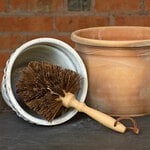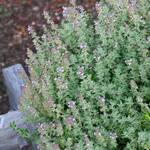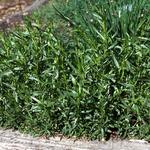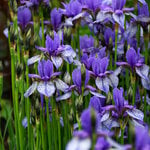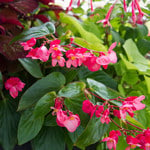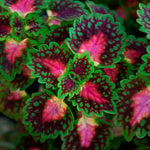Product Details
To enjoy a Rose indoors is to savor the essence of a summer garden in full bloom. Delight giftees (or yourself) with a top-quality, floriferous Rose with lusciously rich pink blossoms, cleanly presented in a white tin cachepot. Just right for enjoying on tables, windowsills, or anywhere you can study the petal-packed flowers up close. Shipped in a 6½" wide x 6" tall metal cachepot.
For more information on growing and care, click Growing Guide.
Shipping
WEATHER PERMITTING - Working with Mother Nature
In our business, we work closely with Mother Nature. In the colder months when we stipulate that an item is shipped “weather permitting”, that means temperatures outside our shipping facility in northwestern Connecticut and along the shipping route must be warm enough for tender plants to survive in unheated delivery trucks. Our practice of waiting for windows of milder weather may result in the occasional delay, but our customers tend to appreciate the care we take to make certain their plants arrive in the very best possible condition. Questions? Don’t hesitate to call our customer service staff at 1-800-411-6159.HOW PLANTS ARE SHIPPED
The size of the plants we ship has been selected to reduce the shock of transplanting. For some, this means a large, bareroot crown. Others cannot travel bareroot or transplant best if grown in containers. We ship these perennials and annuals in 1 pint pots, except as noted. We must point out that many perennials will not bloom the first year after planting, but will the following year, amply rewarding your patience. We ship bulbs as dormant, bare bulbs, sometimes with some wood shavings or moss. Shrubs, Roses, vines, and other woody plants may be shipped bareroot or in pots. The size of the pot is noted in the quick facts for each item.
WHEN WE SHIP
We ship our bulbs and plants at the right time for planting in your area, except as noted, with orders dispatched on a first-come, first-served basis by climate zone. We also ship a wide range of containers and planters, tools, supplies, fertilizers, garden wear, garden decor items, as well as indoor decorations like wreaths and dried bouquets when available. Estimated dates for shipping are indicated in the green Shipping Details box for each item. Please supply a street address for delivery. Kindly contact us with two weeks notice, if you'll be away at the expected time of delivery.
OUR GUARANTEE
We guarantee to ship plants that are in prime condition for growing. If your order is damaged or fails to meet your expectations, we will cheerfully replace or refund it. Please contact our Customer Service Department at 1-800-503-9624 or email us at [email protected]. Please include your order number or customer number when contacting us.
Reviews
There are no reviews yet. Be first to Write a Review.
Growing guide
This charming Rose was specially bred to produce long-lasting flowers and abundant, glossy green leaves. It may be grown year-round as a houseplant or planted outside in Zones 6-10.
GROWING IN A CONTAINER: To grow your Rose indoors as a houseplant, choose an area that receives full sun (at least 6 hours of direct sun each day). A location in a sunny window where the daytime temperature does not go over 75°F and the nightime temperature is above 40°F is ideal.
Watering: When the potting mix feels dry 1 inch below the surface, water thoroughly. Don't let the soil mix dry out completely.
Fertilizing: During fall and winter, fertilize once a month with a balanced houseplant fertilizer (such as 20-20-20). In spring and summer when your Rose is in active growth, fertilize every two weeks.
Moving outdoors: If you would like to move your Rose outdoors for the summer, wait until the danger of frost has passed in spring, then gradually acclimate your plant to conditions outside over a week's time. Set the pot outdoors in a sheltered, lightly shaded spot, increasing the exposure to sun and wind each day. Check the moisture of the potting mix and water thoroughly if it's dry. Once acclimated, keep your plant in full sun for the summer, and bring it back inside before frost in fall if you live in an area that is colder than Zone 6 (-10°F).
Repotting: When the roots of your Rose have become crowded, transplant it into a larger pot. Choose a pot that is 1-2 inches wider in diameter, with a drainage hole in the bottom. Use a fast-draining potting mix, and begin by filling the container about half-full of moistened mix. Remove the plant from the pot by grasping the rim, turning the pot upside down, and tapping it against the heel of your hand. Gently break up the sides of the root ball with your thumbs and tease apart any roots that are circling at the bottom. Then set the root ball on top of the mix and adjust the amount of mix in the container so that the top of the root ball will be about 1 inch below the rim. Fill in around the root ball with potting mix to bring the level to about 1 inch below the rim, and firm lightly. Finally, water thoroughly.
GROWING IN THE GROUND: Gardeners in Zones 6-10 (-10-30°F) can grow this Rose outdoors year-round. Before planting outside in the spring, give your plant a gradual introduction to direct sun and stiff breezes. Set the pot in a sheltered, lightly shaded spot, increasing the exposure to sun and wind each day. Check the potting mix and water thoroughly if it's dry 1 inch below the surface. At the end of a week, your plant will be ready to go into the ground.
Planting: Dig a hole just slightly larger than the pot but no deeper than the pot. Discard half of the soil dug from the hole and replace it with at least as much organic matter -- such as compost, aged manure, or leafmold -- and mix this into the remaining soil. Remove the plant from the pot by grasping the rim, turning the pot upside down, and tapping it against the heel of your hand. If the plant is root-bound (the root ball matted with roots to the point that they all but obscure the potting mix), gently break up the sides of the ball with your thumbs and tease apart roots that are circling at the bottom. Set the root ball in the hole so that the top of the ball is level with the surface of the soil. Then push the mix of soil and organic matter back into the hole, firm the soil, and give the plant a thorough soaking to settle the soil.
Moisture needs: Newly planted Roses need the equivalent of 1 inch of water per week throughout their first growing season. If water doesn't fall from the sky, you must supply it. A generous layer of organic mulch (compost or composted manure is best) helps keep the soil evenly moist.
Fertilizing: Most Roses grow more vigorously, bloom more prolifically, and show greater resistance to diseases if fertilized several times during the growing season -- in early spring, and then monthly, ending in mid-August. (Southern and western gardeners may wish to fertilize more frequently -- fertilizing monthly from early spring until June, pausing during the heat of summer, and fertilizing again in August and September to close out the season.) We prefer natural fertilizers such as fish emulsion or seaweed extract, applied in solution, because they release their nutrients more slowly and evenly than "chemical" fertilizers do.
About pests and diseases: If planted and grown as we suggest, your Rose will be healthy, and healthy plants are much less troubled than plants under stress. Even if a healthy plant does suffer at the hands of a pest or disease, it will likely endure and recover without intervention on the part of the gardener.
Some roses are prone to fungus in hot, humid areas. Cleaning up old foliage and cutting back affected canes is important for disease control. Spraying the leaves with a copper-based fungicide can help once symptoms appear (follow the manufacturer’s instructions).
Pruning: We recommend removing the spent flowers to promote more bloom. Do not prune Roses back in fall; wait until spring to prune branches injured over winter.

